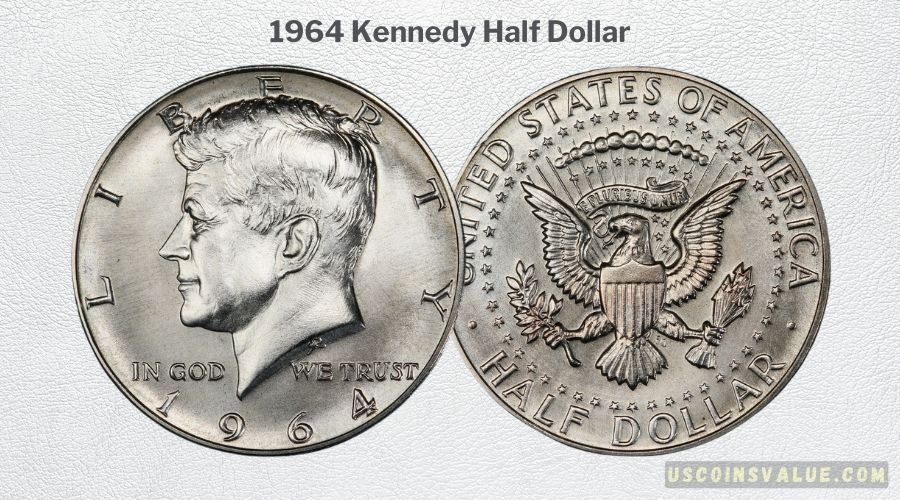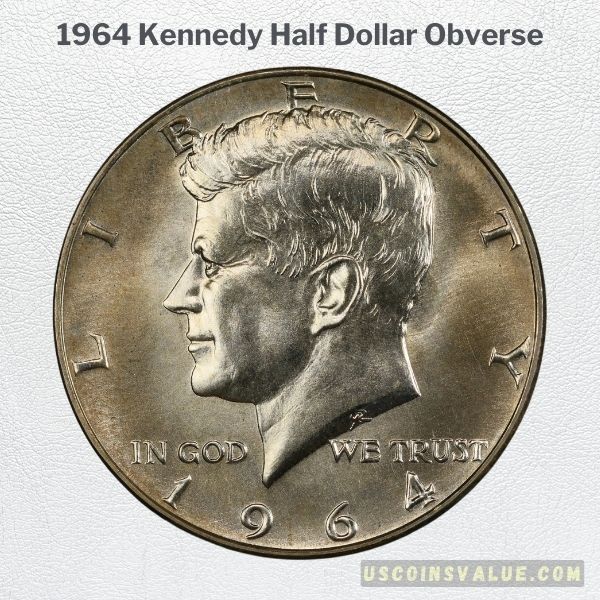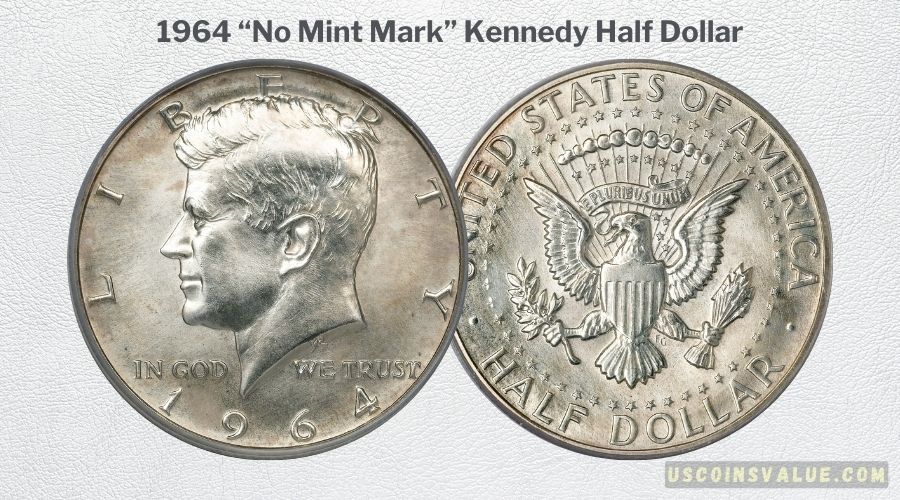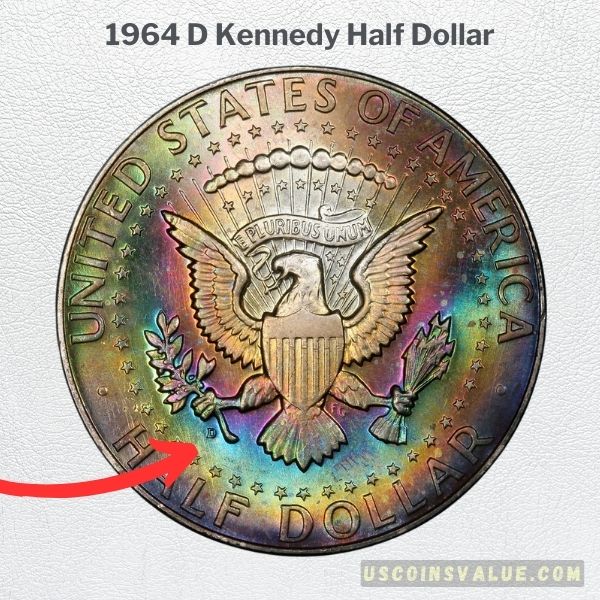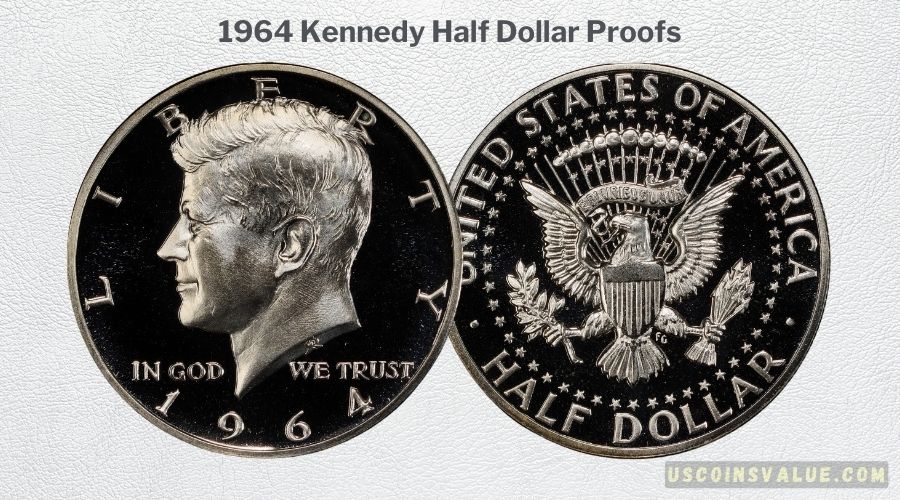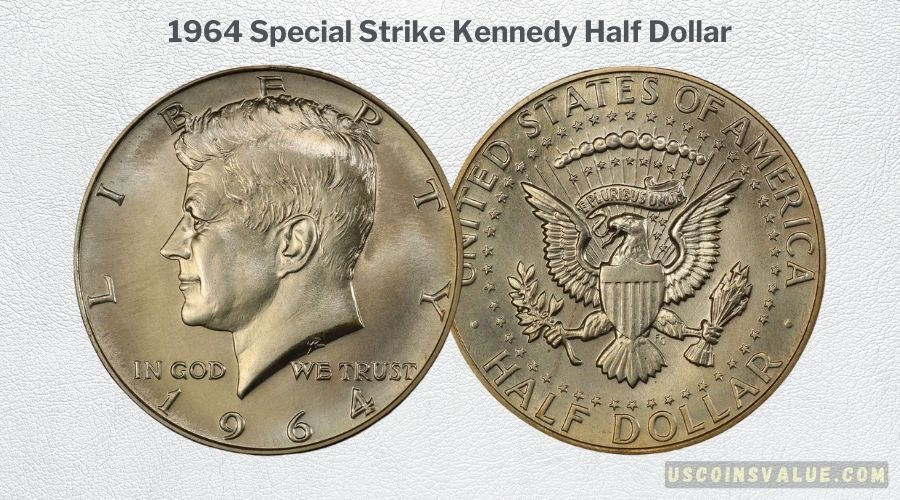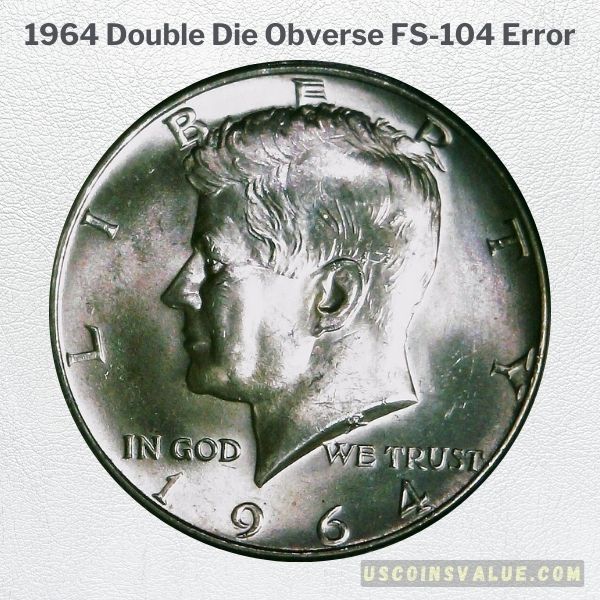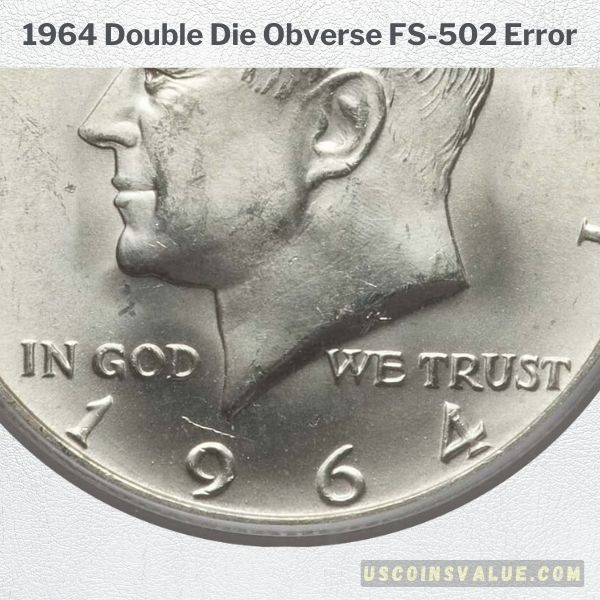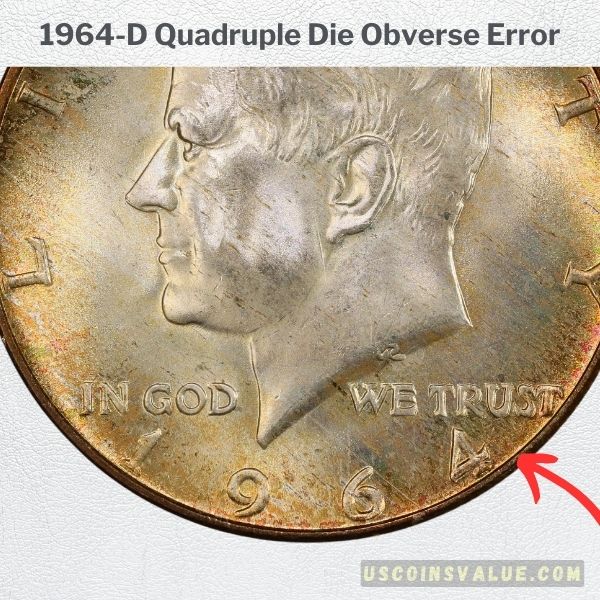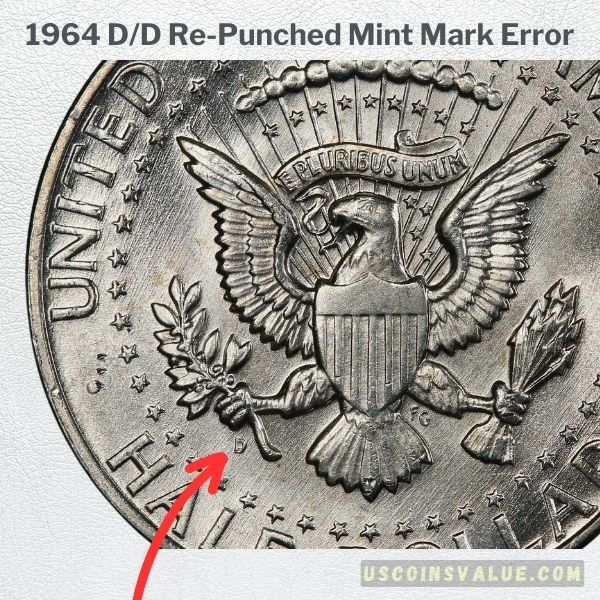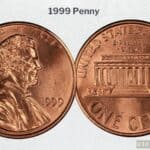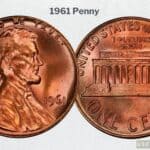Perhaps the most tragic moment for America was the assassination of President J.F. Kennedy in November 1963. However, the US government was not going to let another hero vanish into oblivion.
Therefore, talks of commemorating the fallen leader on a circulating silver coin began. This eventually led to the birth of the Kennedy half-dollar in 1964.
While circulated examples of this coin might not seem valuable, they carry a value ranging from $6 to $15. This is a considerably high price range for a coin with a mere face value of 50-cent.
Some certified, uncirculated specimens can trade for as much as $9,400. Interestingly, in May 2022, a pristine 1964 Kennedy Half Dollar brought in around $48,000 for a collector. These high premiums are a sign of the issue’s purpose and popularity.
Keeping this in mind, let us dive into the history, design, and value of this American treasure. And if you hang around till the very end, you will discover a few fascinating errors in this issue.
A Brief History of the Kennedy Half-Dollar
Did you know the 1964 Kennedy half-dollar is the only circulating Kennedy half-dollar that is 90% silver?
As mentioned above, the Kennedy half dollar was first issued in 1964, a year after the assassination of President J. F. Kennedy. Due to sentimentality, many people scrambled to get these coins, yet very few individuals spent them.
The Kennedy half dollar was an instant success. This led to more than 429 million 1964 Kennedy half dollars being struck between the Philadelphia and Denver mints. This is more than the total amount of Franklin half dollars ever produced.
At the time, the fluctuating prices of silver were looking quite promising. With the first Kennedy half dollars being mostly silver, people started hoarding them. This heightened the coin shortage crisis that the US was facing.
Because of this, Congress resolved to change the coin’s metal composition from silver to a copper-nickel combo. So, the Kennedy halves minted in 1965 went from a 90% silver to a 40% silver composition.
However, at the beginning of 1992, the US Mint started offering a special 90% silver Kennedy Half dollars for sale to collectors. But there was a catch; the coins were only available as proofs. In 1998, the US Mint issued 90% silver Kennedy halves in both brilliant and matte Proos formats.
| Mint | Mint Mark | Mintage |
| Philadelphia | None | 273,304,004 |
| Denver | “D” | 156,205,446 |
| Total | 429,509,450 |
How to Identify a Kennedy Half-Dollar?
Key Details of the 1964 Kennedy Half Dollar
- Category: Kennedy Half Dollars (1964-Date)
- Mint: Philadelphia, Denver
- Mintage: 429,509,450
- Obverse Designer: Gilroy Roberts
- Reverse Designer: Frank Gasparro
- Composition: 90% Silver, 10% Copper
- Fineness: 0.9
- Weight: 12.5g
- Melt Value: $8.70
- Diameter: 30.6mm
- Edge: Reeded
The Obverse
Perhaps one reason coin collectors and enthusiasts love the 1964 Kennedy half-dollar is its unique design that pays homage to the nation’s fallen hero.
As highlighted above, Chief Engraver Gilroy Roberts worked on the obverse of the 1964 half-dollar. He used the Presidential Medal to mold J.F Kennedy’s profile for the coin design.
However, he later included more details about the late president’s hair. That’s after JFK’s wife, Jacqueline Kennedy, made the request.
Along the top edge of the coin is the inscription “LIBERTY”. Right below the president’s profile, running from left to right are the words, is the phrase ‘IN GOD WE TRUST’. And just underneath it is the year of issue–1964.
The Reverse
As we navigate to the reverse of the 1964 half-dollar, things get more interesting. The design used reflects the best works of the renowned engraver – Frank Gasparro.
Drawing inspiration from JFK’s presidential seal, Frank included the American bald eagle at the coin’s back. The bird has its wing spread out and a shield on its chest. On its beak, it holds a scroll with the words “E PLURIBUS UNUM” that’s flying above its head.
Other elements of the reverse design include:
- Arrows – It stands for the strength of the nation
- Olive branch– It symbolizes peace
- A ring of 50 stars–represents the 50 states that form the United States of America
- Inscriptions– “UNITED STATES OF AMERICA” and “ HALF – DOLLAR”.
What’s The Value of the 1964 Half-Dollar?
Above, we talked about how America was facing a coin shortage in the early 1960s. Additionally, with the high prices of silver and the popularity of President John F. Kennedy, people began hoarding coins. To counter these, the US Mint responded by producing large volumes of coins to meet consumer demand.
Thus, with such high production volumes, the 1964 Kennedy half-dollar became quite commonplace. They’re affordable even among collectors. But, since they were first-year issue coins made from 90% silver, the 1964 Kennedy halves were more valuable than their 40% silver counterparts.
The table below provides you with a breakdown of the current market value of the 1964 Half-Dollar:
| 1964 Kennedy Half Dollar Value Chart | ||||
| Mint Mark | Condition | |||
| Circulated | About Uncirculated | MS 60 | MS 65+ | |
| 1964 “no mint mark” Kennedy Half Dollar | $8.50 | $8.75 – $9.25 | $15 – $25 | $40 – $5,200 |
| 1964 “D” Kennedy Half Dollar | $8.50 | $8.75 – $9.25 | $15 – $23 | $42 – $23,500 |
1964 Kennedy Half Dollar Varieties and Their Values
To better understand the cost of the 1964 half-dollar, we have to discuss the value of its varieties, including:
1. 1964 “No Mint Mark” Kennedy Half Dollar
Most of the 1964 half-dollar got minted in the Philadelphia Mint. But out of the 273 million coins struck, only 87,448,004 pieces were struck that year. The remaining were minted in 1965 and 1966 but maintained the date 1964.
Because of the high mintage, one would think circulated 1964 half dollars are super common. However, that’s not the case, since very few pieces stayed in circulation. Most coin collectors and speculators at the time hoarded these coins due to their historical significance and potential future value.
Nevertheless, the 1964 half dollars with no mint mark are readily available in a mint state. Although these pieces maintain a mint luster, most display heavy contact marks and scratches from many years of being traded in bag quantities.
In terms of value, specimens in circulated conditions are worth between $8.50 and $9.25. But in uncirculated conditions, their value increase, with examples in MS64 to MS 66 fetching as much as $1,140. Proof-like 1964 half-dollars are rare and can fetch upwards of $10,350.
Here are other record sales of the 1964 “no mint mark” Kennedy Half Dollars:
| Grade | Price | Auction Firm | Date |
| MS64 | $105 | Heritage Auctions | Apr-2023 |
| MS65 | $288 | Heritage Auctions | Oct-2022 |
| MS66+ | $252 | Heritage Auctions | Apr-2023 |
| MS67 | $660 | Heritage Auctions | Jul-2023 |
| MS67 | $425 | David and Lawrence | Dec-2022 |
| MS67+ | $3,600 | Heritage Auctions | Jul-2022 |
2. 1964-D Kennedy Half Dollar
The 1964-D Kennedy half-dollar is arguably the most minted issue. The Denver mint produced these coins in large numbers–more than 156 million. But the mint only struck 144,411,608 in 1964, and the rest in the subsequent year.
Like with the 1964- no mint mark half-dollar, widespread hoarding depleted the supply in circulation. Because of this, lightly circulated examples graded at AU-50 and lower are super rare today.
Specimen that shows signs of wear and damage can trade for around $6.50 in Very good condition. However, pieces with full mint luster and sharply struck design features have a higher value.
These coins can sell for more than $100, especially in grades MS65 through MS69. A good example is the 1964-D graded at MS 68, which sold for $22,325 at Legend Rare Coins Auctions.
The table below includes the most recent sales of the 1964-D Kennedy half dollar:
| Grade | Price | Auction Firm | Date |
| MS64 | $134 | Heritage Auctions | Aug-2022 |
| MS65 | $129 | Legend Rare Coin Auctions | Nov-2023 |
| MS66 | $4,440 | Heritage Auctions | Aug-2022 |
| MS67 | $408 | Stack’s Bowers | Apr-2023 |
| MS67 | $690 | Heritage Auctions | Aug-2022 |
3. 1964 Kennedy Half Dollar Proofs
The 1964 Proof Kennedy half dollar was the first proof issued by the government for the series. About 4 million proof coins were minted that year at the Philadelphia mint. They fall into three main categories depending on their contrast:
- No Cameo–They’re the most common 1964 half-dollar proofs and have a consistent frosty appearance. Most of these pieces trade for around $10 – $15.
- Cameo proofs–These coins have a more noticeable contrast, which falls between frosty and mirror-like. Unlike no cameo proofs, they are scarce and valued at $14 in PR 60 and $350 in PR69.
- Deep Camero proofs–These 1964 half-dollar displays the highest contrast. However, grading companies have only discovered 104 pieces so far. These can sell anywhere from $100 to $3,300 in grades PR65 to PR69. And if you find a specimen with accentuated hair, you could be looking at some good cash–around $30,000 or more.
Here are some additional recorded sales of the 1964 Proof Kennedy half-dollar:
| Grade | Price | Auction Firm | Date |
| PR64 | $134 | Heritage Auctions | Aug-2022 |
| PR66 | $33 | David Lawrence RC | Oct-2022 |
| PR66DCAM | $159 | Heritage Auctions | Jul-2023 |
| PR67CAM | $119 | Heritage Auctions | Feb-2023 |
| PR68CAM | $100 | Stack’s Bowers | Jul-2023 |
| PR69 DCAM | $2,880 | Heritage Auctions | Dec-2022 |
4. 1964 Special Strike (SMS) Kennedy Half Dollar
The 1964 Special Strike Kennedy half dollar is truly a mystery. They have no mint marks and their production method and purpose remain unknown to date.
What’s more, they are extremely rare, with less than 20 known examples. The first piece appeared in 1993, and since then they have been surfacing for over a decade.
Talking of uniqueness, these special strike coins exhibit sharp, highly detailed strikes. This implies they were struck by quality dies and with the utmost care. Their surfaces are smooth with die polish lines and lack contact marks from circulation or mishandling.
Numismatics believe the Philadelphia Mint struck these pieces as part of an experiment Special Mint Set in 1964.
Due to their rarity and uniqueness, the 1964 SMS Kennedy half dollar demand a very high premium. A sample graded at SP68 sold for $156,000 in 2019 at Stack’s Bowers.
Some other examples include:
| Grade | Price | Auction Firm | Date |
| MS68 | $10,350 | Heritage Auctions | April-2009 |
| SP67 | $38,400 | Heritage Auctions | May-202 |
| SP67+ | $99,875 | Legend Rare Coin Auctions | Sep-2021 |
| SP67 | $108,000 | Heritage Auctions | Apr-2019 |
What Are the Rare Errors in The 1964 Kennedy Half-Dollar?
As we all know, no coin set is ever complete without a few errors, and the 1964 Kennedy half dollar is not exempt. Nearly all 1964 half-dollar error varieties originated from the Denver mint. These errors are valuable, especially as they increase in rarity.
1. 1964 Double Die Obverse FS-104
In the grading system, the FS stands for First Strike. This phrase refers to a coin the grading company received 30 days after being released.
The 1964 Double Die obverse FS-104 exhibits doubling on the lettering and date, where these design elements appear double-struck. This error occurs when the striking dies are not aligned properly during minting.
Like most coin errors, this one is popular among numismatics because of its rarity and unique flaw. As for its value, it can vary depending on its condition. If it’s in mint state, it can sell for as much as $94 or more.
2. 1964 Double Die Obverse FS-502
The 1964 Double Die Obverse (FS-502) error is another doubled die variety worth discussing. Similar to the previous coin above, the half-dollar shows a doubling effect on the inscription “In God, We Trust” and the date. If you look keenly at the coin with a microscope, you can also see the effect on the higher points of the coin.
This coin sold for $199.75 in 2016 at Heritage Auctions.
3. 1964-D Quadruple Die Obverse
The quadruple die obverse is among the rarest error varieties in the Kennedy half-dollar series. The quadrupling error is most visible on the right side of the number 4 on the coin’s year of issue and the ‘U’ of the phrase ‘IN GOD WE TRUST’.
This variety is also referred to as FS-105. In 2022, PCGS had only graded one coin with this error, and it traded for a whopping $1,940 on eBay.
This table provides you with more price information on 1964-D quadruple die obverse error:
| Grade | Price | Auction Firm | Date |
| MS 65 | $139 | Heritage Auctions | Dec-2021 |
| MS 65 | $492 | Heritage Auctions | Jul-2020 |
| MS 66 | $881 | Heritage Auctions | Feb-2017 |
| MS 66 | $823 | Heritage Auctions | Oct-2016 |
4. 1964 D/D Re-punched Mint Mark
As the name implies, this error coin comes with a feature a D mint mark struck twice. The re-punched effect occurs on the mint mark when the dies strike the coin twice by accident or to correct imperfections.
While we don’t have the exact mintage of these error coins, one thing is clear–numismatics highly sought them out.
The key selling point of this error coin is the doubled “D” mint mark on the reverse. However, the second mark seems slightly offset, weaker, and even smaller.
If you suspect your coin has a re-punched mint mark, find a coin microscope and examine it carefully for double impressions.
Based on research, the most expensive 1964 D/D Kennedy half dollar with re-punched mint mark sold for $2,400 in 2020.
Wrapping Up
In summary, the 1964 Kennedy half dollar holds significant value. It’s not only a reminder of a lost hero, but a treasure to cherish. And sometimes, a great source of income. Of course, that’s if you have a one-of-a-kind piece like the 1964 Special Strike Kennedy half dollar.
Nevertheless, don’t just toss your 1964 half-dollar in your change jar, even if it lacks a mint luster. You never know the secret it holds. Maybe it has a unique error like the re-punched mint mark or double die obverse. With these, the value of your coin could rise significantly.
That’s all for today. Hopefully, this article has answered all your questions. If you feel there’s something we’ve missed out, you’re welcome to leave us a comment.

